Cross Cultural Management: National Culture, Leadership, Motivation and HRM
VerifiedAdded on 2023/06/18
|11
|3345
|270
AI Summary
This report discusses the impact of national culture, leadership, motivation and HRM on cross cultural management with a case study of a dam project in Tanzania. It also suggests the use of Hofstede Cultural Dimension Theory and Transformational Leadership Theory for resolving issues of nepotism and tribal rituals.
Contribute Materials
Your contribution can guide someone’s learning journey. Share your
documents today.

Cross Cultural
Management
Management
Secure Best Marks with AI Grader
Need help grading? Try our AI Grader for instant feedback on your assignments.
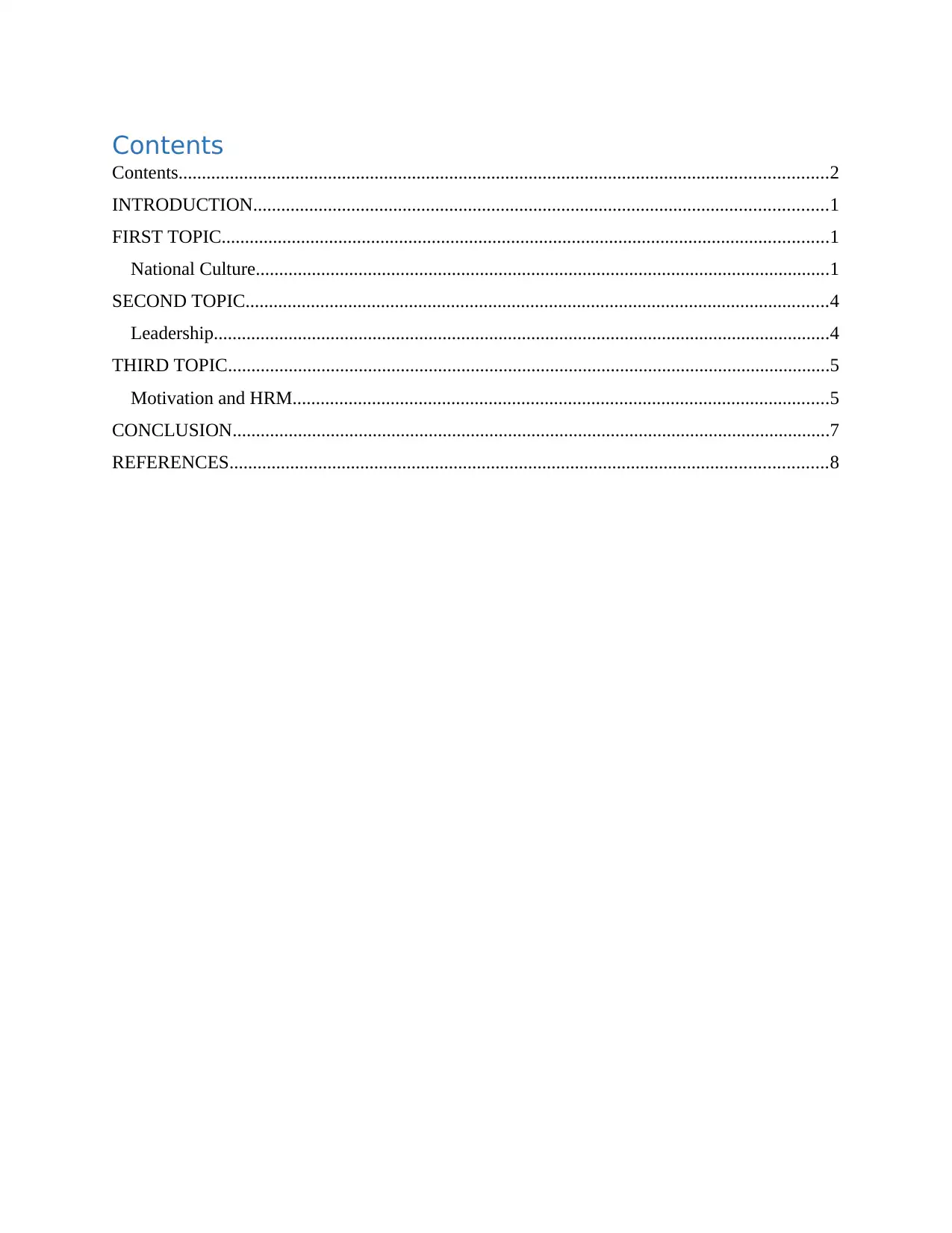
Contents
Contents...........................................................................................................................................2
INTRODUCTION...........................................................................................................................1
FIRST TOPIC..................................................................................................................................1
National Culture...........................................................................................................................1
SECOND TOPIC.............................................................................................................................4
Leadership....................................................................................................................................4
THIRD TOPIC.................................................................................................................................5
Motivation and HRM...................................................................................................................5
CONCLUSION................................................................................................................................7
REFERENCES................................................................................................................................8
Contents...........................................................................................................................................2
INTRODUCTION...........................................................................................................................1
FIRST TOPIC..................................................................................................................................1
National Culture...........................................................................................................................1
SECOND TOPIC.............................................................................................................................4
Leadership....................................................................................................................................4
THIRD TOPIC.................................................................................................................................5
Motivation and HRM...................................................................................................................5
CONCLUSION................................................................................................................................7
REFERENCES................................................................................................................................8
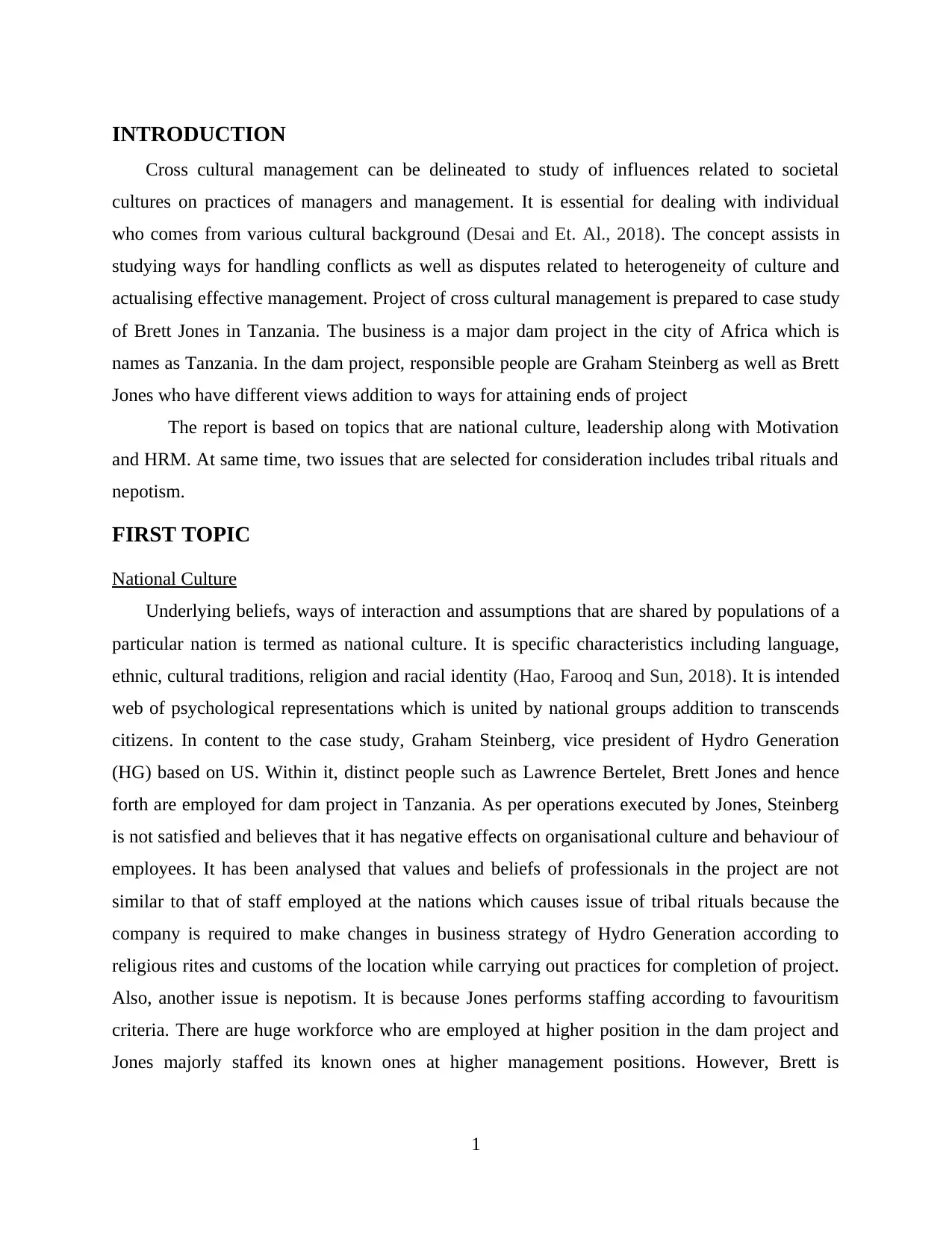
INTRODUCTION
Cross cultural management can be delineated to study of influences related to societal
cultures on practices of managers and management. It is essential for dealing with individual
who comes from various cultural background (Desai and Et. Al., 2018). The concept assists in
studying ways for handling conflicts as well as disputes related to heterogeneity of culture and
actualising effective management. Project of cross cultural management is prepared to case study
of Brett Jones in Tanzania. The business is a major dam project in the city of Africa which is
names as Tanzania. In the dam project, responsible people are Graham Steinberg as well as Brett
Jones who have different views addition to ways for attaining ends of project
The report is based on topics that are national culture, leadership along with Motivation
and HRM. At same time, two issues that are selected for consideration includes tribal rituals and
nepotism.
FIRST TOPIC
National Culture
Underlying beliefs, ways of interaction and assumptions that are shared by populations of a
particular nation is termed as national culture. It is specific characteristics including language,
ethnic, cultural traditions, religion and racial identity (Hao, Farooq and Sun, 2018). It is intended
web of psychological representations which is united by national groups addition to transcends
citizens. In content to the case study, Graham Steinberg, vice president of Hydro Generation
(HG) based on US. Within it, distinct people such as Lawrence Bertelet, Brett Jones and hence
forth are employed for dam project in Tanzania. As per operations executed by Jones, Steinberg
is not satisfied and believes that it has negative effects on organisational culture and behaviour of
employees. It has been analysed that values and beliefs of professionals in the project are not
similar to that of staff employed at the nations which causes issue of tribal rituals because the
company is required to make changes in business strategy of Hydro Generation according to
religious rites and customs of the location while carrying out practices for completion of project.
Also, another issue is nepotism. It is because Jones performs staffing according to favouritism
criteria. There are huge workforce who are employed at higher position in the dam project and
Jones majorly staffed its known ones at higher management positions. However, Brett is
1
Cross cultural management can be delineated to study of influences related to societal
cultures on practices of managers and management. It is essential for dealing with individual
who comes from various cultural background (Desai and Et. Al., 2018). The concept assists in
studying ways for handling conflicts as well as disputes related to heterogeneity of culture and
actualising effective management. Project of cross cultural management is prepared to case study
of Brett Jones in Tanzania. The business is a major dam project in the city of Africa which is
names as Tanzania. In the dam project, responsible people are Graham Steinberg as well as Brett
Jones who have different views addition to ways for attaining ends of project
The report is based on topics that are national culture, leadership along with Motivation
and HRM. At same time, two issues that are selected for consideration includes tribal rituals and
nepotism.
FIRST TOPIC
National Culture
Underlying beliefs, ways of interaction and assumptions that are shared by populations of a
particular nation is termed as national culture. It is specific characteristics including language,
ethnic, cultural traditions, religion and racial identity (Hao, Farooq and Sun, 2018). It is intended
web of psychological representations which is united by national groups addition to transcends
citizens. In content to the case study, Graham Steinberg, vice president of Hydro Generation
(HG) based on US. Within it, distinct people such as Lawrence Bertelet, Brett Jones and hence
forth are employed for dam project in Tanzania. As per operations executed by Jones, Steinberg
is not satisfied and believes that it has negative effects on organisational culture and behaviour of
employees. It has been analysed that values and beliefs of professionals in the project are not
similar to that of staff employed at the nations which causes issue of tribal rituals because the
company is required to make changes in business strategy of Hydro Generation according to
religious rites and customs of the location while carrying out practices for completion of project.
Also, another issue is nepotism. It is because Jones performs staffing according to favouritism
criteria. There are huge workforce who are employed at higher position in the dam project and
Jones majorly staffed its known ones at higher management positions. However, Brett is
1
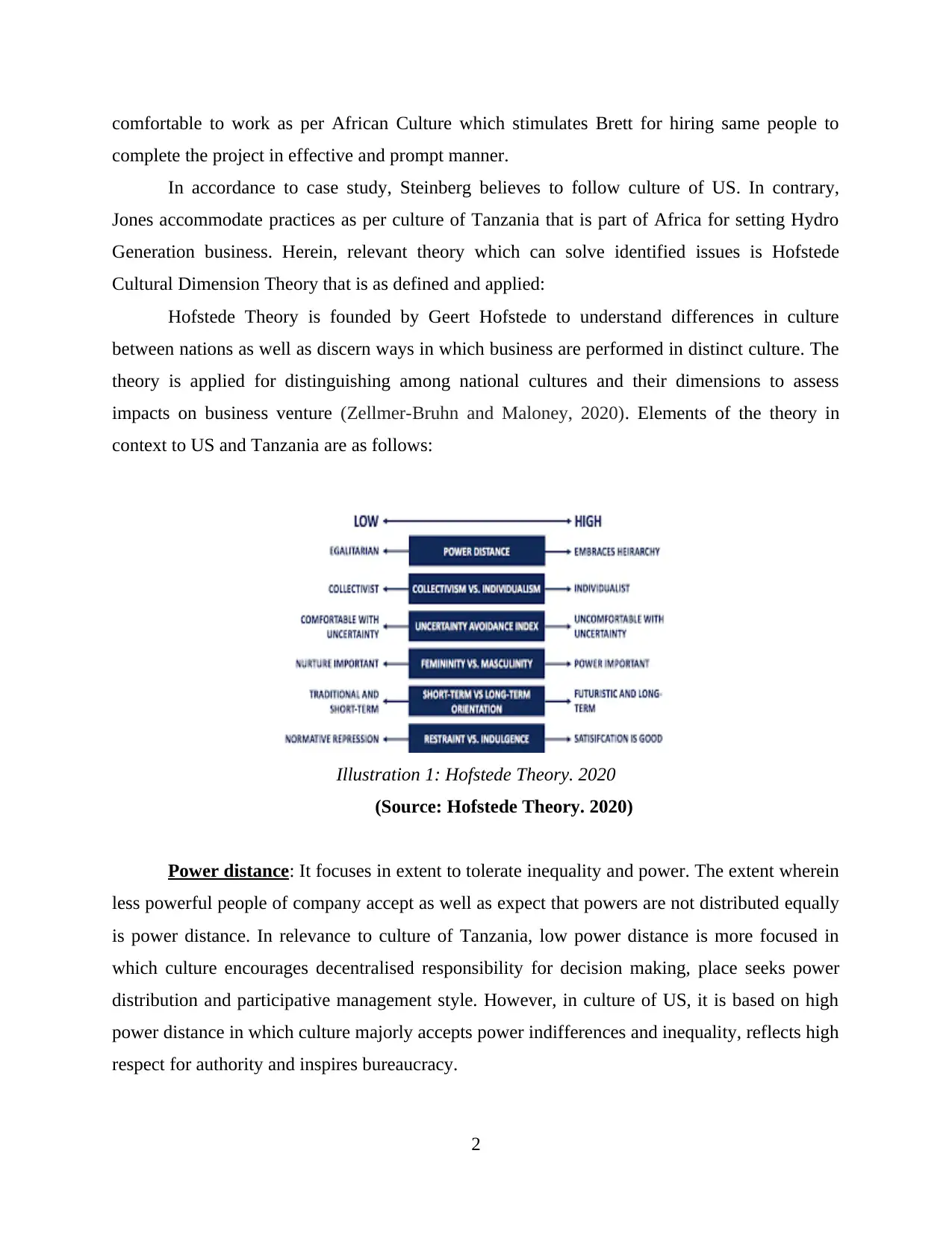
comfortable to work as per African Culture which stimulates Brett for hiring same people to
complete the project in effective and prompt manner.
In accordance to case study, Steinberg believes to follow culture of US. In contrary,
Jones accommodate practices as per culture of Tanzania that is part of Africa for setting Hydro
Generation business. Herein, relevant theory which can solve identified issues is Hofstede
Cultural Dimension Theory that is as defined and applied:
Hofstede Theory is founded by Geert Hofstede to understand differences in culture
between nations as well as discern ways in which business are performed in distinct culture. The
theory is applied for distinguishing among national cultures and their dimensions to assess
impacts on business venture (Zellmer-Bruhn and Maloney, 2020). Elements of the theory in
context to US and Tanzania are as follows:
Illustration 1: Hofstede Theory. 2020
(Source: Hofstede Theory. 2020)
Power distance: It focuses in extent to tolerate inequality and power. The extent wherein
less powerful people of company accept as well as expect that powers are not distributed equally
is power distance. In relevance to culture of Tanzania, low power distance is more focused in
which culture encourages decentralised responsibility for decision making, place seeks power
distribution and participative management style. However, in culture of US, it is based on high
power distance in which culture majorly accepts power indifferences and inequality, reflects high
respect for authority and inspires bureaucracy.
2
complete the project in effective and prompt manner.
In accordance to case study, Steinberg believes to follow culture of US. In contrary,
Jones accommodate practices as per culture of Tanzania that is part of Africa for setting Hydro
Generation business. Herein, relevant theory which can solve identified issues is Hofstede
Cultural Dimension Theory that is as defined and applied:
Hofstede Theory is founded by Geert Hofstede to understand differences in culture
between nations as well as discern ways in which business are performed in distinct culture. The
theory is applied for distinguishing among national cultures and their dimensions to assess
impacts on business venture (Zellmer-Bruhn and Maloney, 2020). Elements of the theory in
context to US and Tanzania are as follows:
Illustration 1: Hofstede Theory. 2020
(Source: Hofstede Theory. 2020)
Power distance: It focuses in extent to tolerate inequality and power. The extent wherein
less powerful people of company accept as well as expect that powers are not distributed equally
is power distance. In relevance to culture of Tanzania, low power distance is more focused in
which culture encourages decentralised responsibility for decision making, place seeks power
distribution and participative management style. However, in culture of US, it is based on high
power distance in which culture majorly accepts power indifferences and inequality, reflects high
respect for authority and inspires bureaucracy.
2
Secure Best Marks with AI Grader
Need help grading? Try our AI Grader for instant feedback on your assignments.
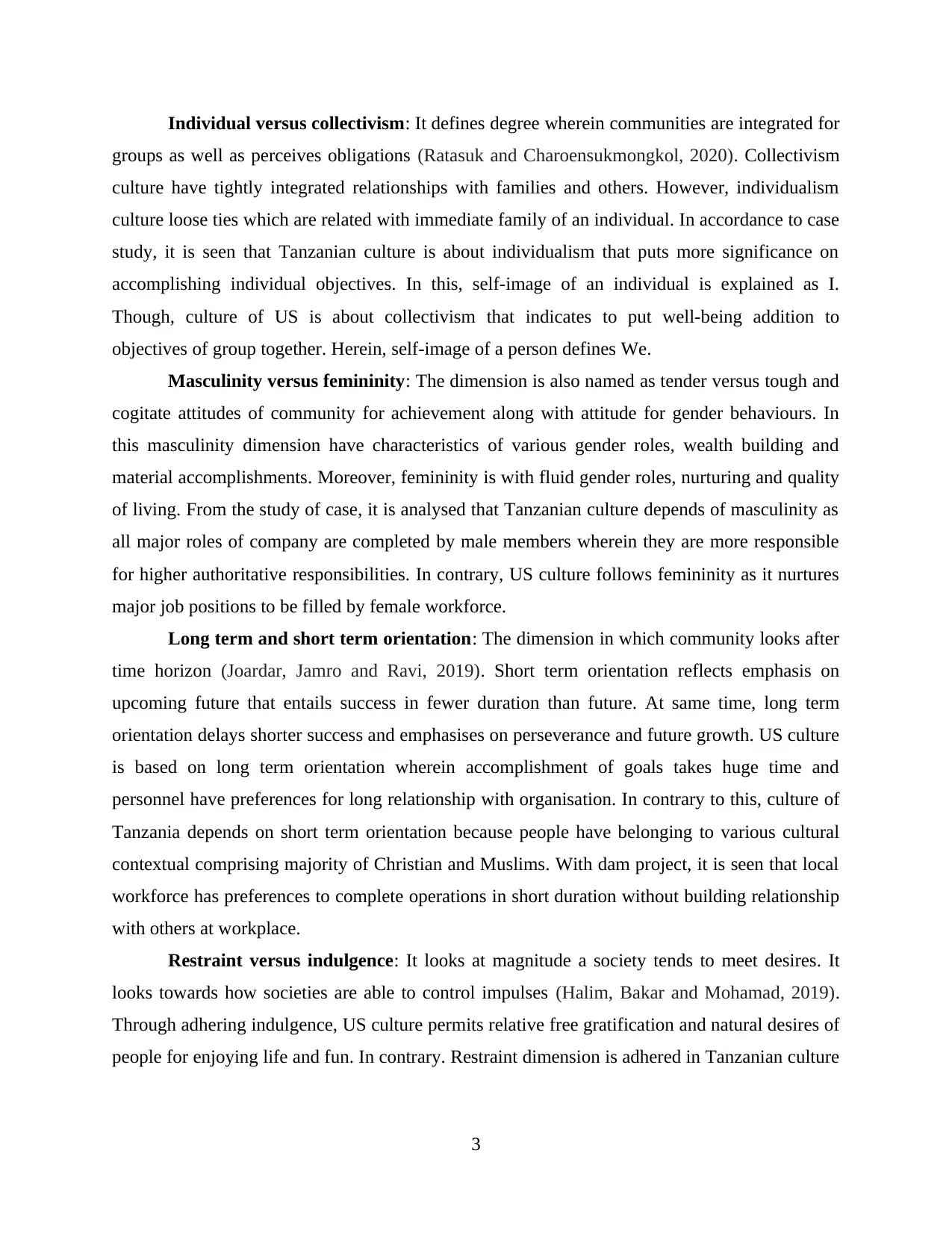
Individual versus collectivism: It defines degree wherein communities are integrated for
groups as well as perceives obligations (Ratasuk and Charoensukmongkol, 2020). Collectivism
culture have tightly integrated relationships with families and others. However, individualism
culture loose ties which are related with immediate family of an individual. In accordance to case
study, it is seen that Tanzanian culture is about individualism that puts more significance on
accomplishing individual objectives. In this, self-image of an individual is explained as I.
Though, culture of US is about collectivism that indicates to put well-being addition to
objectives of group together. Herein, self-image of a person defines We.
Masculinity versus femininity: The dimension is also named as tender versus tough and
cogitate attitudes of community for achievement along with attitude for gender behaviours. In
this masculinity dimension have characteristics of various gender roles, wealth building and
material accomplishments. Moreover, femininity is with fluid gender roles, nurturing and quality
of living. From the study of case, it is analysed that Tanzanian culture depends of masculinity as
all major roles of company are completed by male members wherein they are more responsible
for higher authoritative responsibilities. In contrary, US culture follows femininity as it nurtures
major job positions to be filled by female workforce.
Long term and short term orientation: The dimension in which community looks after
time horizon (Joardar, Jamro and Ravi, 2019). Short term orientation reflects emphasis on
upcoming future that entails success in fewer duration than future. At same time, long term
orientation delays shorter success and emphasises on perseverance and future growth. US culture
is based on long term orientation wherein accomplishment of goals takes huge time and
personnel have preferences for long relationship with organisation. In contrary to this, culture of
Tanzania depends on short term orientation because people have belonging to various cultural
contextual comprising majority of Christian and Muslims. With dam project, it is seen that local
workforce has preferences to complete operations in short duration without building relationship
with others at workplace.
Restraint versus indulgence: It looks at magnitude a society tends to meet desires. It
looks towards how societies are able to control impulses (Halim, Bakar and Mohamad, 2019).
Through adhering indulgence, US culture permits relative free gratification and natural desires of
people for enjoying life and fun. In contrary. Restraint dimension is adhered in Tanzanian culture
3
groups as well as perceives obligations (Ratasuk and Charoensukmongkol, 2020). Collectivism
culture have tightly integrated relationships with families and others. However, individualism
culture loose ties which are related with immediate family of an individual. In accordance to case
study, it is seen that Tanzanian culture is about individualism that puts more significance on
accomplishing individual objectives. In this, self-image of an individual is explained as I.
Though, culture of US is about collectivism that indicates to put well-being addition to
objectives of group together. Herein, self-image of a person defines We.
Masculinity versus femininity: The dimension is also named as tender versus tough and
cogitate attitudes of community for achievement along with attitude for gender behaviours. In
this masculinity dimension have characteristics of various gender roles, wealth building and
material accomplishments. Moreover, femininity is with fluid gender roles, nurturing and quality
of living. From the study of case, it is analysed that Tanzanian culture depends of masculinity as
all major roles of company are completed by male members wherein they are more responsible
for higher authoritative responsibilities. In contrary, US culture follows femininity as it nurtures
major job positions to be filled by female workforce.
Long term and short term orientation: The dimension in which community looks after
time horizon (Joardar, Jamro and Ravi, 2019). Short term orientation reflects emphasis on
upcoming future that entails success in fewer duration than future. At same time, long term
orientation delays shorter success and emphasises on perseverance and future growth. US culture
is based on long term orientation wherein accomplishment of goals takes huge time and
personnel have preferences for long relationship with organisation. In contrary to this, culture of
Tanzania depends on short term orientation because people have belonging to various cultural
contextual comprising majority of Christian and Muslims. With dam project, it is seen that local
workforce has preferences to complete operations in short duration without building relationship
with others at workplace.
Restraint versus indulgence: It looks at magnitude a society tends to meet desires. It
looks towards how societies are able to control impulses (Halim, Bakar and Mohamad, 2019).
Through adhering indulgence, US culture permits relative free gratification and natural desires of
people for enjoying life and fun. In contrary. Restraint dimension is adhered in Tanzanian culture
3
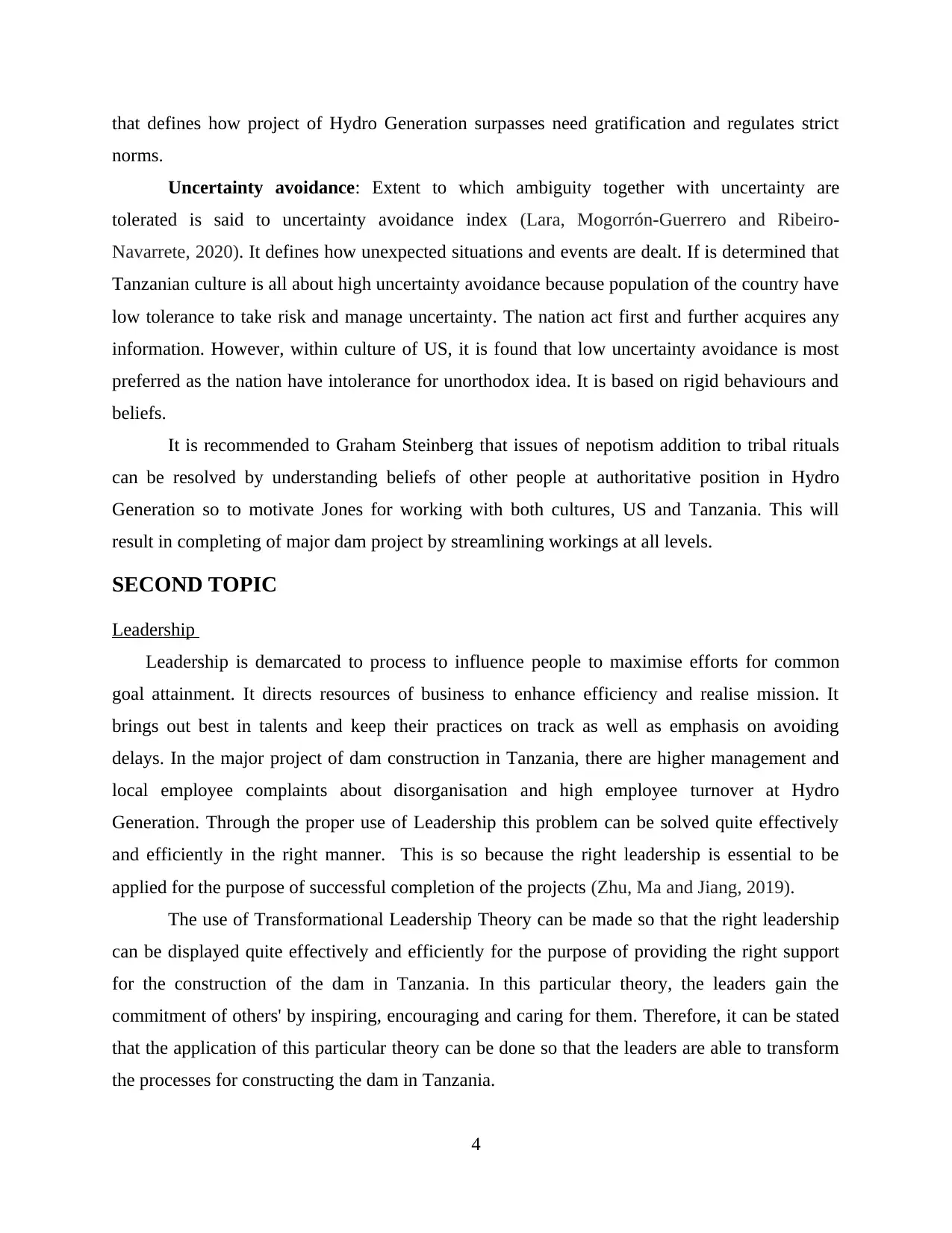
that defines how project of Hydro Generation surpasses need gratification and regulates strict
norms.
Uncertainty avoidance: Extent to which ambiguity together with uncertainty are
tolerated is said to uncertainty avoidance index (Lara, Mogorrón-Guerrero and Ribeiro-
Navarrete, 2020). It defines how unexpected situations and events are dealt. If is determined that
Tanzanian culture is all about high uncertainty avoidance because population of the country have
low tolerance to take risk and manage uncertainty. The nation act first and further acquires any
information. However, within culture of US, it is found that low uncertainty avoidance is most
preferred as the nation have intolerance for unorthodox idea. It is based on rigid behaviours and
beliefs.
It is recommended to Graham Steinberg that issues of nepotism addition to tribal rituals
can be resolved by understanding beliefs of other people at authoritative position in Hydro
Generation so to motivate Jones for working with both cultures, US and Tanzania. This will
result in completing of major dam project by streamlining workings at all levels.
SECOND TOPIC
Leadership
Leadership is demarcated to process to influence people to maximise efforts for common
goal attainment. It directs resources of business to enhance efficiency and realise mission. It
brings out best in talents and keep their practices on track as well as emphasis on avoiding
delays. In the major project of dam construction in Tanzania, there are higher management and
local employee complaints about disorganisation and high employee turnover at Hydro
Generation. Through the proper use of Leadership this problem can be solved quite effectively
and efficiently in the right manner. This is so because the right leadership is essential to be
applied for the purpose of successful completion of the projects (Zhu, Ma and Jiang, 2019).
The use of Transformational Leadership Theory can be made so that the right leadership
can be displayed quite effectively and efficiently for the purpose of providing the right support
for the construction of the dam in Tanzania. In this particular theory, the leaders gain the
commitment of others' by inspiring, encouraging and caring for them. Therefore, it can be stated
that the application of this particular theory can be done so that the leaders are able to transform
the processes for constructing the dam in Tanzania.
4
norms.
Uncertainty avoidance: Extent to which ambiguity together with uncertainty are
tolerated is said to uncertainty avoidance index (Lara, Mogorrón-Guerrero and Ribeiro-
Navarrete, 2020). It defines how unexpected situations and events are dealt. If is determined that
Tanzanian culture is all about high uncertainty avoidance because population of the country have
low tolerance to take risk and manage uncertainty. The nation act first and further acquires any
information. However, within culture of US, it is found that low uncertainty avoidance is most
preferred as the nation have intolerance for unorthodox idea. It is based on rigid behaviours and
beliefs.
It is recommended to Graham Steinberg that issues of nepotism addition to tribal rituals
can be resolved by understanding beliefs of other people at authoritative position in Hydro
Generation so to motivate Jones for working with both cultures, US and Tanzania. This will
result in completing of major dam project by streamlining workings at all levels.
SECOND TOPIC
Leadership
Leadership is demarcated to process to influence people to maximise efforts for common
goal attainment. It directs resources of business to enhance efficiency and realise mission. It
brings out best in talents and keep their practices on track as well as emphasis on avoiding
delays. In the major project of dam construction in Tanzania, there are higher management and
local employee complaints about disorganisation and high employee turnover at Hydro
Generation. Through the proper use of Leadership this problem can be solved quite effectively
and efficiently in the right manner. This is so because the right leadership is essential to be
applied for the purpose of successful completion of the projects (Zhu, Ma and Jiang, 2019).
The use of Transformational Leadership Theory can be made so that the right leadership
can be displayed quite effectively and efficiently for the purpose of providing the right support
for the construction of the dam in Tanzania. In this particular theory, the leaders gain the
commitment of others' by inspiring, encouraging and caring for them. Therefore, it can be stated
that the application of this particular theory can be done so that the leaders are able to transform
the processes for constructing the dam in Tanzania.
4
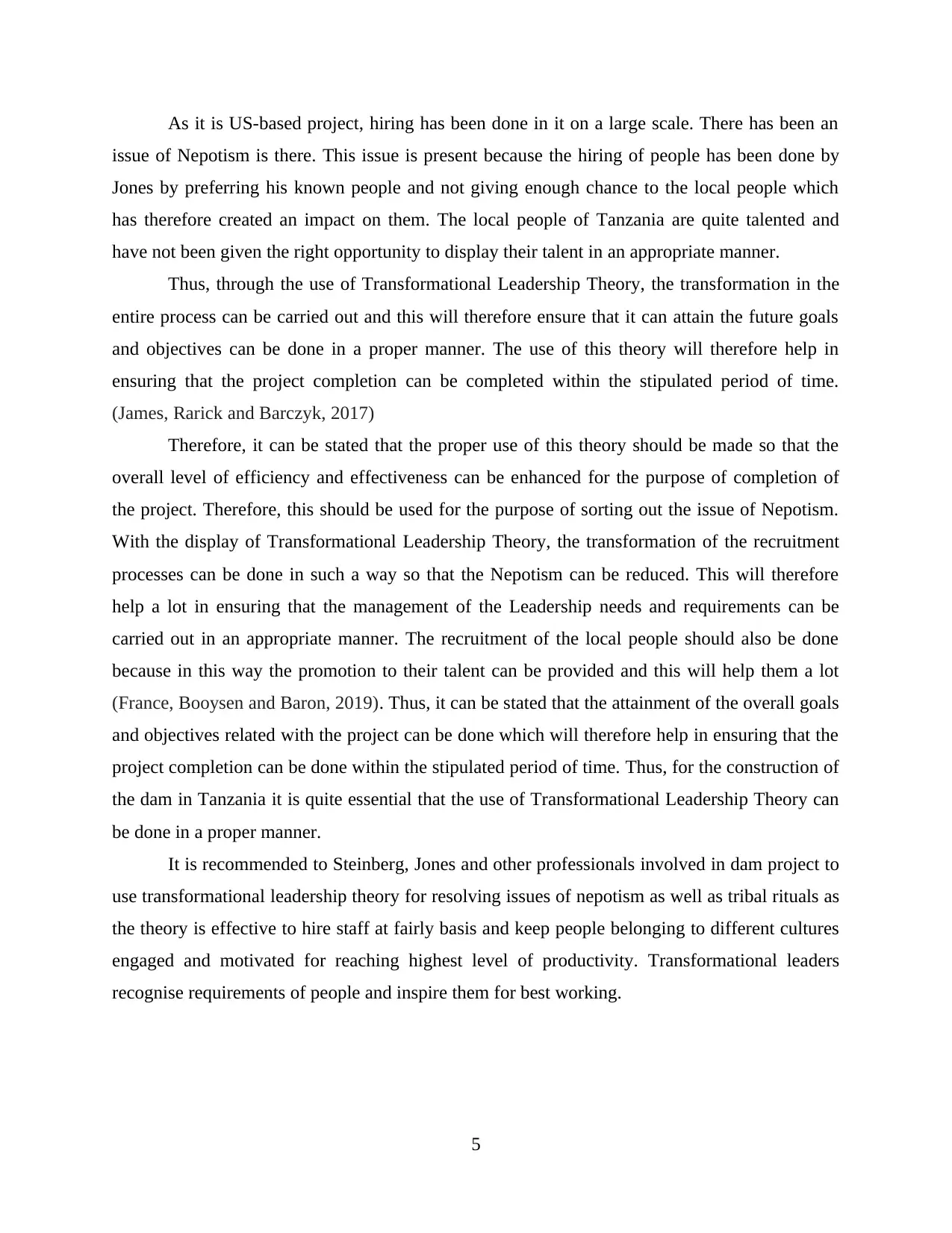
As it is US-based project, hiring has been done in it on a large scale. There has been an
issue of Nepotism is there. This issue is present because the hiring of people has been done by
Jones by preferring his known people and not giving enough chance to the local people which
has therefore created an impact on them. The local people of Tanzania are quite talented and
have not been given the right opportunity to display their talent in an appropriate manner.
Thus, through the use of Transformational Leadership Theory, the transformation in the
entire process can be carried out and this will therefore ensure that it can attain the future goals
and objectives can be done in a proper manner. The use of this theory will therefore help in
ensuring that the project completion can be completed within the stipulated period of time.
(James, Rarick and Barczyk, 2017)
Therefore, it can be stated that the proper use of this theory should be made so that the
overall level of efficiency and effectiveness can be enhanced for the purpose of completion of
the project. Therefore, this should be used for the purpose of sorting out the issue of Nepotism.
With the display of Transformational Leadership Theory, the transformation of the recruitment
processes can be done in such a way so that the Nepotism can be reduced. This will therefore
help a lot in ensuring that the management of the Leadership needs and requirements can be
carried out in an appropriate manner. The recruitment of the local people should also be done
because in this way the promotion to their talent can be provided and this will help them a lot
(France, Booysen and Baron, 2019). Thus, it can be stated that the attainment of the overall goals
and objectives related with the project can be done which will therefore help in ensuring that the
project completion can be done within the stipulated period of time. Thus, for the construction of
the dam in Tanzania it is quite essential that the use of Transformational Leadership Theory can
be done in a proper manner.
It is recommended to Steinberg, Jones and other professionals involved in dam project to
use transformational leadership theory for resolving issues of nepotism as well as tribal rituals as
the theory is effective to hire staff at fairly basis and keep people belonging to different cultures
engaged and motivated for reaching highest level of productivity. Transformational leaders
recognise requirements of people and inspire them for best working.
5
issue of Nepotism is there. This issue is present because the hiring of people has been done by
Jones by preferring his known people and not giving enough chance to the local people which
has therefore created an impact on them. The local people of Tanzania are quite talented and
have not been given the right opportunity to display their talent in an appropriate manner.
Thus, through the use of Transformational Leadership Theory, the transformation in the
entire process can be carried out and this will therefore ensure that it can attain the future goals
and objectives can be done in a proper manner. The use of this theory will therefore help in
ensuring that the project completion can be completed within the stipulated period of time.
(James, Rarick and Barczyk, 2017)
Therefore, it can be stated that the proper use of this theory should be made so that the
overall level of efficiency and effectiveness can be enhanced for the purpose of completion of
the project. Therefore, this should be used for the purpose of sorting out the issue of Nepotism.
With the display of Transformational Leadership Theory, the transformation of the recruitment
processes can be done in such a way so that the Nepotism can be reduced. This will therefore
help a lot in ensuring that the management of the Leadership needs and requirements can be
carried out in an appropriate manner. The recruitment of the local people should also be done
because in this way the promotion to their talent can be provided and this will help them a lot
(France, Booysen and Baron, 2019). Thus, it can be stated that the attainment of the overall goals
and objectives related with the project can be done which will therefore help in ensuring that the
project completion can be done within the stipulated period of time. Thus, for the construction of
the dam in Tanzania it is quite essential that the use of Transformational Leadership Theory can
be done in a proper manner.
It is recommended to Steinberg, Jones and other professionals involved in dam project to
use transformational leadership theory for resolving issues of nepotism as well as tribal rituals as
the theory is effective to hire staff at fairly basis and keep people belonging to different cultures
engaged and motivated for reaching highest level of productivity. Transformational leaders
recognise requirements of people and inspire them for best working.
5
Paraphrase This Document
Need a fresh take? Get an instant paraphrase of this document with our AI Paraphraser
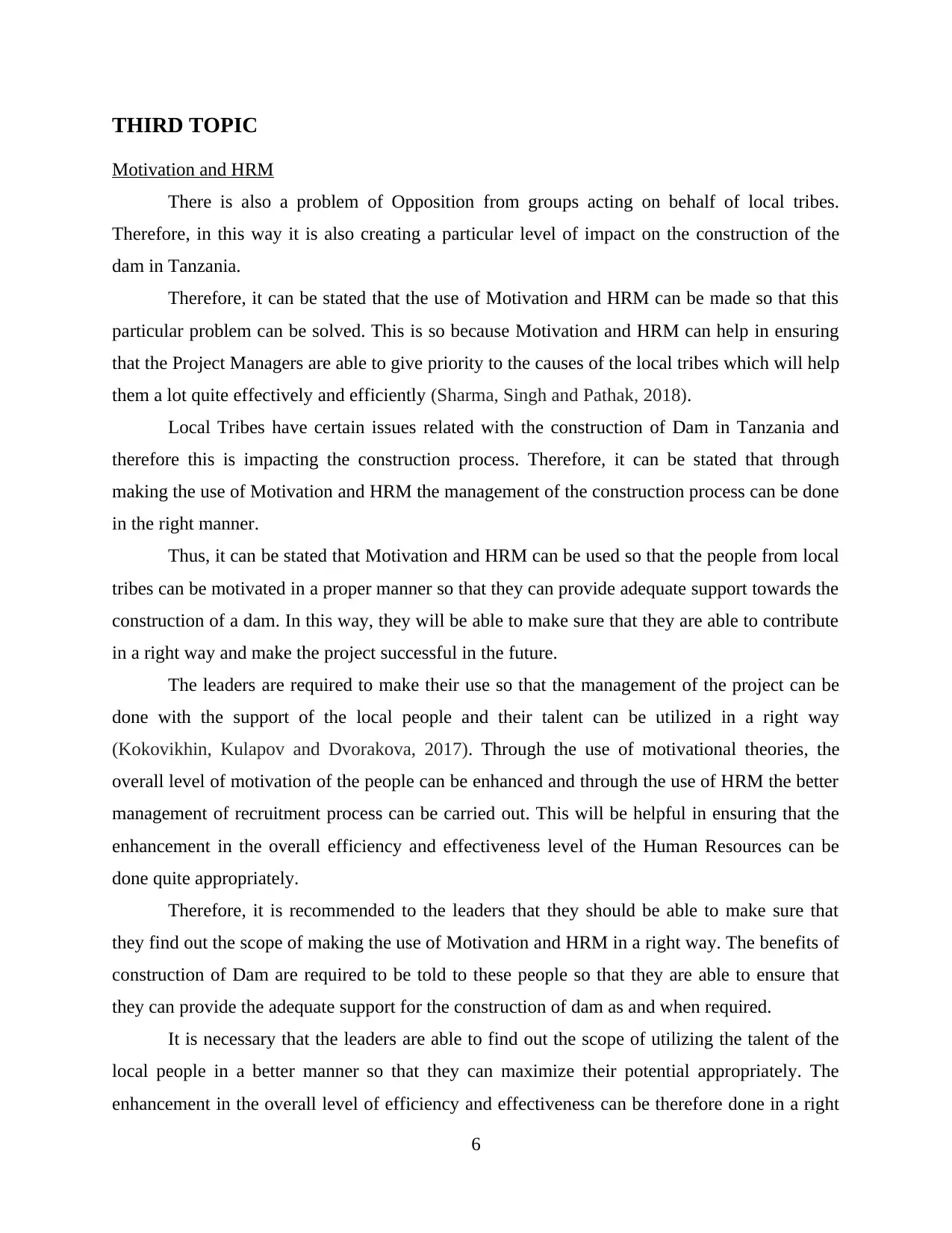
THIRD TOPIC
Motivation and HRM
There is also a problem of Opposition from groups acting on behalf of local tribes.
Therefore, in this way it is also creating a particular level of impact on the construction of the
dam in Tanzania.
Therefore, it can be stated that the use of Motivation and HRM can be made so that this
particular problem can be solved. This is so because Motivation and HRM can help in ensuring
that the Project Managers are able to give priority to the causes of the local tribes which will help
them a lot quite effectively and efficiently (Sharma, Singh and Pathak, 2018).
Local Tribes have certain issues related with the construction of Dam in Tanzania and
therefore this is impacting the construction process. Therefore, it can be stated that through
making the use of Motivation and HRM the management of the construction process can be done
in the right manner.
Thus, it can be stated that Motivation and HRM can be used so that the people from local
tribes can be motivated in a proper manner so that they can provide adequate support towards the
construction of a dam. In this way, they will be able to make sure that they are able to contribute
in a right way and make the project successful in the future.
The leaders are required to make their use so that the management of the project can be
done with the support of the local people and their talent can be utilized in a right way
(Kokovikhin, Kulapov and Dvorakova, 2017). Through the use of motivational theories, the
overall level of motivation of the people can be enhanced and through the use of HRM the better
management of recruitment process can be carried out. This will be helpful in ensuring that the
enhancement in the overall efficiency and effectiveness level of the Human Resources can be
done quite appropriately.
Therefore, it is recommended to the leaders that they should be able to make sure that
they find out the scope of making the use of Motivation and HRM in a right way. The benefits of
construction of Dam are required to be told to these people so that they are able to ensure that
they can provide the adequate support for the construction of dam as and when required.
It is necessary that the leaders are able to find out the scope of utilizing the talent of the
local people in a better manner so that they can maximize their potential appropriately. The
enhancement in the overall level of efficiency and effectiveness can be therefore done in a right
6
Motivation and HRM
There is also a problem of Opposition from groups acting on behalf of local tribes.
Therefore, in this way it is also creating a particular level of impact on the construction of the
dam in Tanzania.
Therefore, it can be stated that the use of Motivation and HRM can be made so that this
particular problem can be solved. This is so because Motivation and HRM can help in ensuring
that the Project Managers are able to give priority to the causes of the local tribes which will help
them a lot quite effectively and efficiently (Sharma, Singh and Pathak, 2018).
Local Tribes have certain issues related with the construction of Dam in Tanzania and
therefore this is impacting the construction process. Therefore, it can be stated that through
making the use of Motivation and HRM the management of the construction process can be done
in the right manner.
Thus, it can be stated that Motivation and HRM can be used so that the people from local
tribes can be motivated in a proper manner so that they can provide adequate support towards the
construction of a dam. In this way, they will be able to make sure that they are able to contribute
in a right way and make the project successful in the future.
The leaders are required to make their use so that the management of the project can be
done with the support of the local people and their talent can be utilized in a right way
(Kokovikhin, Kulapov and Dvorakova, 2017). Through the use of motivational theories, the
overall level of motivation of the people can be enhanced and through the use of HRM the better
management of recruitment process can be carried out. This will be helpful in ensuring that the
enhancement in the overall efficiency and effectiveness level of the Human Resources can be
done quite appropriately.
Therefore, it is recommended to the leaders that they should be able to make sure that
they find out the scope of making the use of Motivation and HRM in a right way. The benefits of
construction of Dam are required to be told to these people so that they are able to ensure that
they can provide the adequate support for the construction of dam as and when required.
It is necessary that the leaders are able to find out the scope of utilizing the talent of the
local people in a better manner so that they can maximize their potential appropriately. The
enhancement in the overall level of efficiency and effectiveness can be therefore done in a right
6
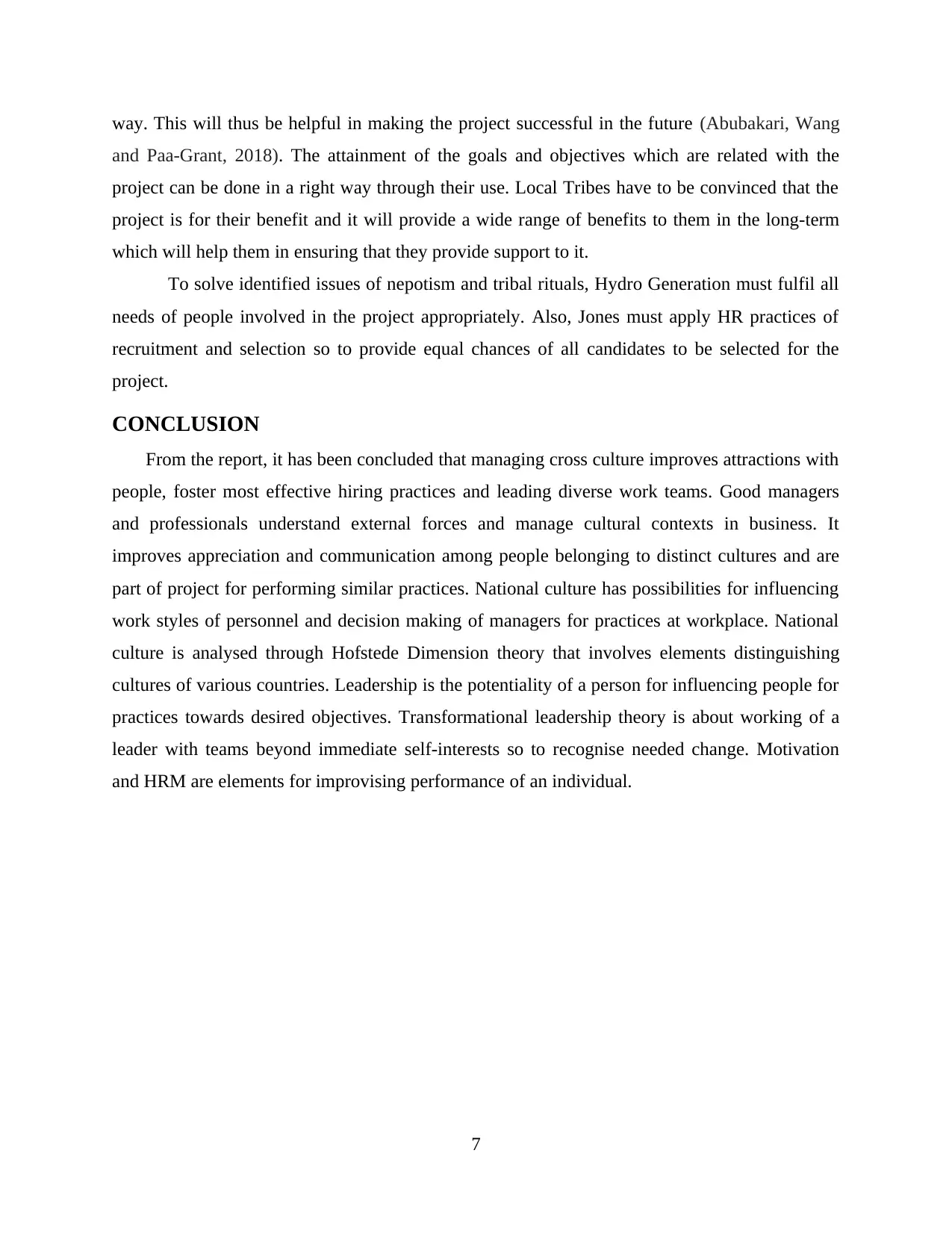
way. This will thus be helpful in making the project successful in the future (Abubakari, Wang
and Paa-Grant, 2018). The attainment of the goals and objectives which are related with the
project can be done in a right way through their use. Local Tribes have to be convinced that the
project is for their benefit and it will provide a wide range of benefits to them in the long-term
which will help them in ensuring that they provide support to it.
To solve identified issues of nepotism and tribal rituals, Hydro Generation must fulfil all
needs of people involved in the project appropriately. Also, Jones must apply HR practices of
recruitment and selection so to provide equal chances of all candidates to be selected for the
project.
CONCLUSION
From the report, it has been concluded that managing cross culture improves attractions with
people, foster most effective hiring practices and leading diverse work teams. Good managers
and professionals understand external forces and manage cultural contexts in business. It
improves appreciation and communication among people belonging to distinct cultures and are
part of project for performing similar practices. National culture has possibilities for influencing
work styles of personnel and decision making of managers for practices at workplace. National
culture is analysed through Hofstede Dimension theory that involves elements distinguishing
cultures of various countries. Leadership is the potentiality of a person for influencing people for
practices towards desired objectives. Transformational leadership theory is about working of a
leader with teams beyond immediate self-interests so to recognise needed change. Motivation
and HRM are elements for improvising performance of an individual.
7
and Paa-Grant, 2018). The attainment of the goals and objectives which are related with the
project can be done in a right way through their use. Local Tribes have to be convinced that the
project is for their benefit and it will provide a wide range of benefits to them in the long-term
which will help them in ensuring that they provide support to it.
To solve identified issues of nepotism and tribal rituals, Hydro Generation must fulfil all
needs of people involved in the project appropriately. Also, Jones must apply HR practices of
recruitment and selection so to provide equal chances of all candidates to be selected for the
project.
CONCLUSION
From the report, it has been concluded that managing cross culture improves attractions with
people, foster most effective hiring practices and leading diverse work teams. Good managers
and professionals understand external forces and manage cultural contexts in business. It
improves appreciation and communication among people belonging to distinct cultures and are
part of project for performing similar practices. National culture has possibilities for influencing
work styles of personnel and decision making of managers for practices at workplace. National
culture is analysed through Hofstede Dimension theory that involves elements distinguishing
cultures of various countries. Leadership is the potentiality of a person for influencing people for
practices towards desired objectives. Transformational leadership theory is about working of a
leader with teams beyond immediate self-interests so to recognise needed change. Motivation
and HRM are elements for improvising performance of an individual.
7
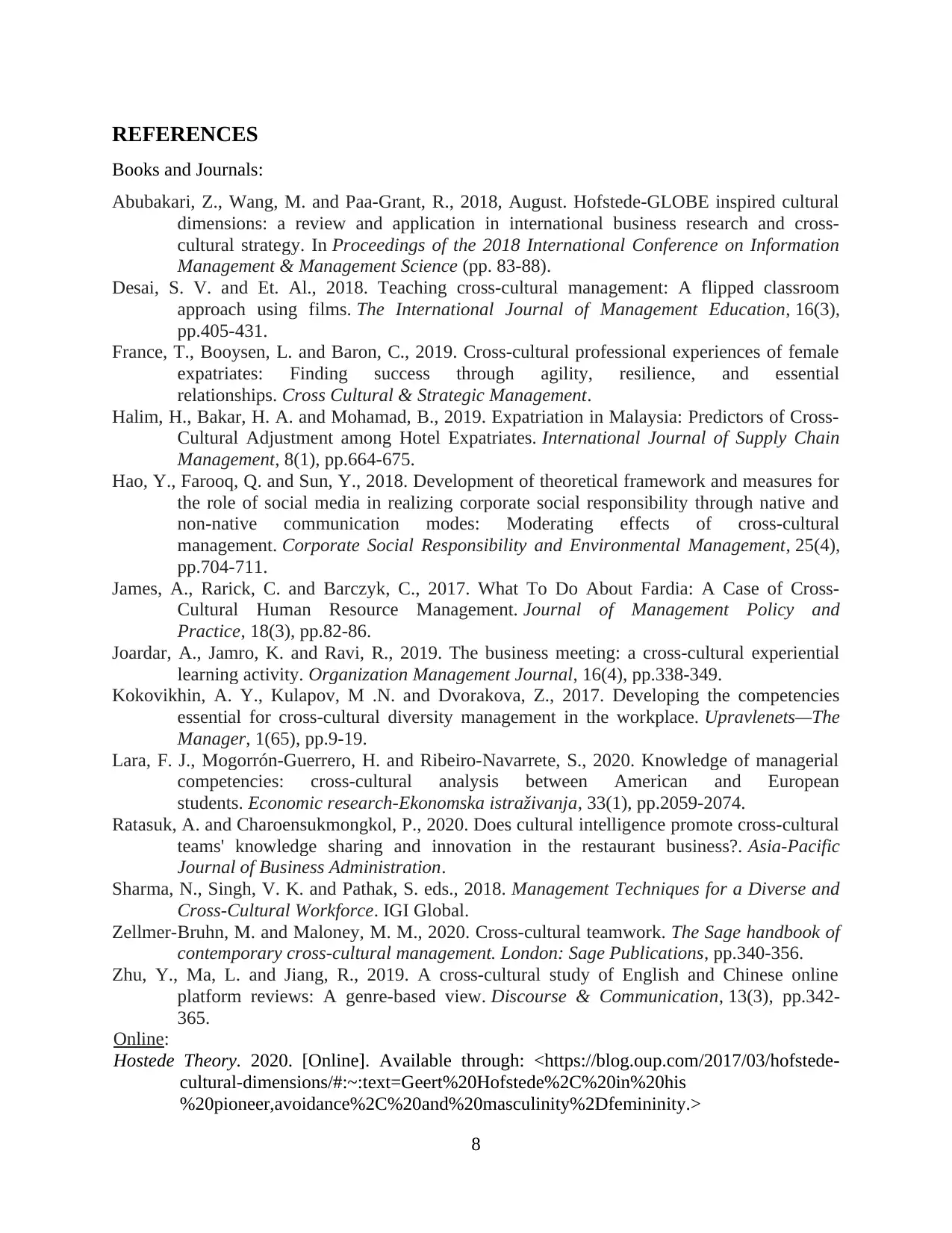
REFERENCES
Books and Journals:
Abubakari, Z., Wang, M. and Paa-Grant, R., 2018, August. Hofstede-GLOBE inspired cultural
dimensions: a review and application in international business research and cross-
cultural strategy. In Proceedings of the 2018 International Conference on Information
Management & Management Science (pp. 83-88).
Desai, S. V. and Et. Al., 2018. Teaching cross-cultural management: A flipped classroom
approach using films. The International Journal of Management Education, 16(3),
pp.405-431.
France, T., Booysen, L. and Baron, C., 2019. Cross-cultural professional experiences of female
expatriates: Finding success through agility, resilience, and essential
relationships. Cross Cultural & Strategic Management.
Halim, H., Bakar, H. A. and Mohamad, B., 2019. Expatriation in Malaysia: Predictors of Cross-
Cultural Adjustment among Hotel Expatriates. International Journal of Supply Chain
Management, 8(1), pp.664-675.
Hao, Y., Farooq, Q. and Sun, Y., 2018. Development of theoretical framework and measures for
the role of social media in realizing corporate social responsibility through native and
non‐native communication modes: Moderating effects of cross‐cultural
management. Corporate Social Responsibility and Environmental Management, 25(4),
pp.704-711.
James, A., Rarick, C. and Barczyk, C., 2017. What To Do About Fardia: A Case of Cross-
Cultural Human Resource Management. Journal of Management Policy and
Practice, 18(3), pp.82-86.
Joardar, A., Jamro, K. and Ravi, R., 2019. The business meeting: a cross-cultural experiential
learning activity. Organization Management Journal, 16(4), pp.338-349.
Kokovikhin, A. Y., Kulapov, M .N. and Dvorakova, Z., 2017. Developing the competencies
essential for cross-cultural diversity management in the workplace. Upravlenets—The
Manager, 1(65), pp.9-19.
Lara, F. J., Mogorrón-Guerrero, H. and Ribeiro-Navarrete, S., 2020. Knowledge of managerial
competencies: cross-cultural analysis between American and European
students. Economic research-Ekonomska istraživanja, 33(1), pp.2059-2074.
Ratasuk, A. and Charoensukmongkol, P., 2020. Does cultural intelligence promote cross-cultural
teams' knowledge sharing and innovation in the restaurant business?. Asia-Pacific
Journal of Business Administration.
Sharma, N., Singh, V. K. and Pathak, S. eds., 2018. Management Techniques for a Diverse and
Cross-Cultural Workforce. IGI Global.
Zellmer-Bruhn, M. and Maloney, M. M., 2020. Cross-cultural teamwork. The Sage handbook of
contemporary cross-cultural management. London: Sage Publications, pp.340-356.
Zhu, Y., Ma, L. and Jiang, R., 2019. A cross-cultural study of English and Chinese online
platform reviews: A genre-based view. Discourse & Communication, 13(3), pp.342-
365.
Online:
Hostede Theory. 2020. [Online]. Available through: <https://blog.oup.com/2017/03/hofstede-
cultural-dimensions/#:~:text=Geert%20Hofstede%2C%20in%20his
%20pioneer,avoidance%2C%20and%20masculinity%2Dfemininity.>
8
Books and Journals:
Abubakari, Z., Wang, M. and Paa-Grant, R., 2018, August. Hofstede-GLOBE inspired cultural
dimensions: a review and application in international business research and cross-
cultural strategy. In Proceedings of the 2018 International Conference on Information
Management & Management Science (pp. 83-88).
Desai, S. V. and Et. Al., 2018. Teaching cross-cultural management: A flipped classroom
approach using films. The International Journal of Management Education, 16(3),
pp.405-431.
France, T., Booysen, L. and Baron, C., 2019. Cross-cultural professional experiences of female
expatriates: Finding success through agility, resilience, and essential
relationships. Cross Cultural & Strategic Management.
Halim, H., Bakar, H. A. and Mohamad, B., 2019. Expatriation in Malaysia: Predictors of Cross-
Cultural Adjustment among Hotel Expatriates. International Journal of Supply Chain
Management, 8(1), pp.664-675.
Hao, Y., Farooq, Q. and Sun, Y., 2018. Development of theoretical framework and measures for
the role of social media in realizing corporate social responsibility through native and
non‐native communication modes: Moderating effects of cross‐cultural
management. Corporate Social Responsibility and Environmental Management, 25(4),
pp.704-711.
James, A., Rarick, C. and Barczyk, C., 2017. What To Do About Fardia: A Case of Cross-
Cultural Human Resource Management. Journal of Management Policy and
Practice, 18(3), pp.82-86.
Joardar, A., Jamro, K. and Ravi, R., 2019. The business meeting: a cross-cultural experiential
learning activity. Organization Management Journal, 16(4), pp.338-349.
Kokovikhin, A. Y., Kulapov, M .N. and Dvorakova, Z., 2017. Developing the competencies
essential for cross-cultural diversity management in the workplace. Upravlenets—The
Manager, 1(65), pp.9-19.
Lara, F. J., Mogorrón-Guerrero, H. and Ribeiro-Navarrete, S., 2020. Knowledge of managerial
competencies: cross-cultural analysis between American and European
students. Economic research-Ekonomska istraživanja, 33(1), pp.2059-2074.
Ratasuk, A. and Charoensukmongkol, P., 2020. Does cultural intelligence promote cross-cultural
teams' knowledge sharing and innovation in the restaurant business?. Asia-Pacific
Journal of Business Administration.
Sharma, N., Singh, V. K. and Pathak, S. eds., 2018. Management Techniques for a Diverse and
Cross-Cultural Workforce. IGI Global.
Zellmer-Bruhn, M. and Maloney, M. M., 2020. Cross-cultural teamwork. The Sage handbook of
contemporary cross-cultural management. London: Sage Publications, pp.340-356.
Zhu, Y., Ma, L. and Jiang, R., 2019. A cross-cultural study of English and Chinese online
platform reviews: A genre-based view. Discourse & Communication, 13(3), pp.342-
365.
Online:
Hostede Theory. 2020. [Online]. Available through: <https://blog.oup.com/2017/03/hofstede-
cultural-dimensions/#:~:text=Geert%20Hofstede%2C%20in%20his
%20pioneer,avoidance%2C%20and%20masculinity%2Dfemininity.>
8
Secure Best Marks with AI Grader
Need help grading? Try our AI Grader for instant feedback on your assignments.

9
1 out of 11
Your All-in-One AI-Powered Toolkit for Academic Success.
+13062052269
info@desklib.com
Available 24*7 on WhatsApp / Email
![[object Object]](/_next/static/media/star-bottom.7253800d.svg)
Unlock your academic potential
© 2024 | Zucol Services PVT LTD | All rights reserved.





